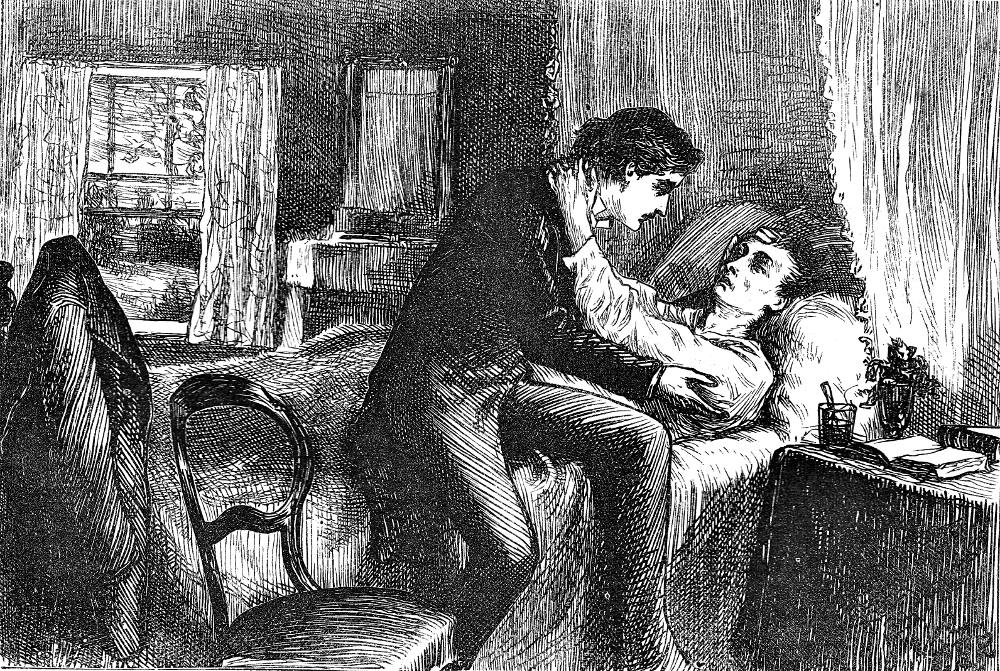
Nicholas and the dying Smike (1924, p. 100) — Harold Copping's version of a Dickens deathbed scene in Children's stories from Dickens. Line drawing in lithography. 4 ⅛ by 4 ¾ inches (10.6 x 12 cm), vignetted. [Click on image to enlarge it.]
Passage Illustrated: Smike, Tended by Nicholas, is "not afraid to die"
I am sorry to tell you, however, that this happiness did not last long [after Smike had escaped from Squeers]. Poor Smike began to droop, and became more ill day by day and week by week. And he was always haunted with a fearful dread that that awful man Squeers would pounce upon him again and carry him away. The truth was the poor boy was dying.
And now Nicholas began to see that hope was gone, and that upon the partner of his poverty and the sharer of his better fortune the world was closing fast. There was little pain, little uneasiness, but there was nio rallying, no effort, no struggle for life. He was worn and wasted to the last degree; his voice had sunk so low that he could scarce be heard to speak. Nature was thoroughly exhausted, and he had lain him down to die.
On as fine, mild autumn day, when all was tranquil and at peace, when the soft sweet air crept in at the open window of the quiet room, and not a sound was heard but the gentle rustling of leaves, Nicholas sat in his old place by the bedside, and knew that the time was nearly come. So very still it was, that, every now and then, he bent down his ear to listen for the breathing of him who lay asleep . . . . ["Smike, and Dotheboys Hall," Children's Stories from Dickens, pp. 96-97]
Commentary: Copping Adjusts the Ending from Triumphant to Tragic
Copping presents the sentimental death of Smike with Nicholas by his bedside rather than a realisation of the classroom scene at the end of the chapter when the Yorkshire farmer (not named as John Browdie) bursts in to rescue Squeers' wife and daughter. When a chorus of shrill voices announces that poetic justice has been served on the Squeers family since the schoolmaster has been sent to prison, the boys resolve to break out. As the school empties out and the sounds of cheering boys has died away, the reader encounters this sentimental tailpiece. The actual dying of Smike in the text occurs four pages earlier, so that, whereas Mary Angela Dickens ends the chapter on a high note, emphasizing the breaking up of Dotheboys Hall, Copping forces the reader to reflect upon the death of the boy whose nightmares were haunted by the spectre of Squeers. For the sake of simplicity and to maintain the focus of the narrative on Smike, Mary Angela Dickens has completely eliminated the theatrical sojourn of the cousins.
The Conclusion of Smike's Story in the Novel's Other Programs of Illustration (1838-1910)


Left: Harry Furniss focuses on Smike's gradual mental and physical deterioration of ritual dosing in Chapter LVIII of the novel: Smike's Delusion (1910). Right: Phiz's equivalent scene in the serial recalls the death of Smike: The Children at Their Cousin's Grave (October 1839).


Left: C. S. Reinhart's less caricatural and more realistic version of the death of Smike: "Now," he murmured, "I am happy.". Right: Phiz is not clear in his caption that Brooker is merely a conjuration of the dying Smike's fancy: The Recognition (September 1839).
Related material, including front matter and sketches, by other illustrators
- Nicholas Nickleby (homepage)
- Phiz's 38 monthly illustrations for the novel, April 1938-October 1839
- "Hush!" said Nicholas, laying his hand upon his shoulder. (Vol. 1, 1861)
- The Rehearsal (Vol. 2, 1861)
- "My son, sir, little Wackford. What do you think of him, sir?" (Vol. 3, 1861)
- Newman had caught up by the nozzle an old pair of bellows . . . (Vol. 4, 1861).
- Sol Eytinge, Jr.'s 18 illustrations for The Diamond Edition (1867)
- Fred Barnard's 59 Illustrations for the Household Edution (1877)
- C. S. Reinhart's 52 Illustrations for the American Household Edution (1875)
- Harry Furniss's 29 illustrations for Nicholas Nickleby in the Charles Dickens Library Edition (1910)
- Kyd's four Player's Cigarette Cards (1910)
Scanned image, colour correction, sizing, caption, and commentary by Philip V. Allingham. [You may use this image without prior permission for any scholarly or educational purpose, as long as you (1) credit the person who scanned the image, and (2) link your document to this URL in a web document or cite the Victorian Web in a print one.]
Bibliography
Barnard, J. "Fred" (il.). Charles Dickens's Nicholas Nickleby, with fifty-nine illustrations. The Works of Charles Dickens: The Household Edition. 22 vols. London: Chapman and Hall, 1875. Volume 15. Rpt. 1890.
Dickens, Charles. The Life and Adventures of Nicholas Nickleby. Illustrated by Phiz (Hablot Knight Browne). London: Chapman and Hall, 1839.
Dickens, Mary Angela, Percy Fitzgerald, Captain Edric Vredenburg, and Others. Illustrated by Harold Copping with eleven coloured lithographs. Children's Stories from Dickens. London: Raphael Tuck, 1893.
Matz, B. W., and Kate Perugini; illustrated by Harold Copping. "Nicholas Nickleby." Character Sketches from Dickens. London: Raphael Tuck, 1924. Pp. 39-51.
Created 12 October 2023